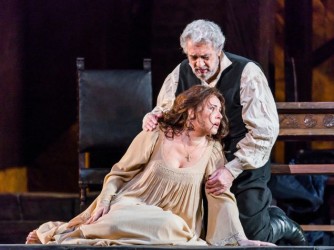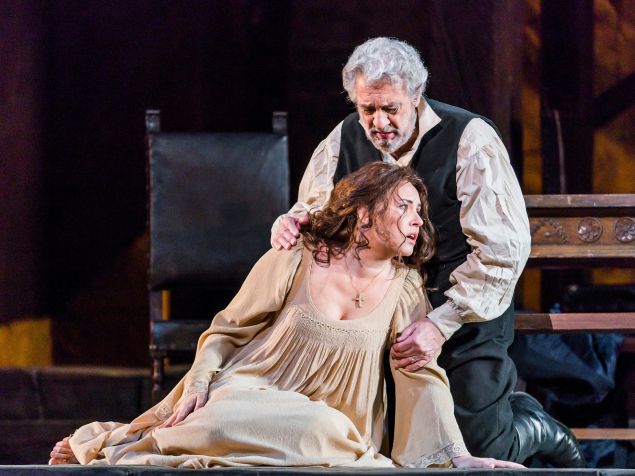 United States Verdi, Luisa Miller: Soloists, Chorus and Orchestra of the Metropolitan Opera, New York / Bertrand de Billy (conductor), Met Live in HD broadcast to the Cineworld Basildon, Essex, 14.4.2018. (JPr)
United States Verdi, Luisa Miller: Soloists, Chorus and Orchestra of the Metropolitan Opera, New York / Bertrand de Billy (conductor), Met Live in HD broadcast to the Cineworld Basildon, Essex, 14.4.2018. (JPr)

Cast:
Luisa – Sonya Yoncheva
Federica – Olesya Petrova
Rodolfo – Piotr Beczała
Miller – Plácido Domingo
Count Walter – Alexander Vinogradov
Wurm – Dmitry Belosselskiy
Laura – Rihab Chaieb
Production:
Production – Elijah Moshinsky
Stage Director – Gregory Keller
Set and costume designer – Santo Loquasto
Lighting designer – Duane Schuler
Live in HD director – Matthew Diamond
Live in HD host – Anthony Roth Costanzo
When Luisa Miller was premiered in 1849 Verdi’s best years were ahead of him beginning with Rigoletto, La traviata and Il trovatore which are the peaks of the composer’s ‘middle period’. Luisa Miller needs the calibre of singers seen at the Met to really make it work because the music often sounds as if it is Verdi trying things out for those operas – and others – he was yet to compose. Don’t get me wrong there is some wonderful music including ‘Sacra la scelta è d’un consorte’ for Miller, a retired soldier, ‘Lo vidi e’l primo palpito’ and ‘Tu puniscimi, O Signore’ for Luisa, his daughter, and ‘Quando le sere al placido’ for Rodolfo, her love interest. Apart from this principal trio there are also some other believable characters such as Count Walter, Rodolfo’s father, and the perfectly named Wurm, his steward.
Salvadore Cammarano’s libretto was based on Schiller’s play Kabale und Liebe (Intrigue and Love). The original action was moved to a seventeenth-century Tyrolean village from a prince’s court a century later. He moved the motivations of the characters away from Schiller’s princely intrigues (Kabale) and more toward the Liebe (Love) aspect of his source. Because this is early Verdi the plot is not entirely plausible and isn’t as affecting as Traviata or complicated as Don Carlos or as perfect as Otello. Nevertheless, Luisa Miller is interesting for its themes of thwarted love against the background of the religious and political conflicts of the time.
In years to come Verdi might have balanced the overt sentimentalism with a bit more politics, but not in 1849. The plot has two young people in love – Luisa and Rodolfo (initially in disguise) – when Rodolfo reveals who he loves to his father, he is forbidden from seeing the lowly-born Luisa and told to marry Federica, a widowed duchess. In order to save her father’s life Luisa is tricked into declaring her love for the duplicitous Wurm. It all end in tears, trauma, a poisoned drink and a drawn-out triple death scene that Verdi will revisit in his seminal masterpiece Otello. What Verdi lacks in dramaturgy, he makes up for through his imaginatively constructed aria and scene structure and intriguing orchestrations. He even eschews the familiar banda in favour of some atmospheric off-stage Tyrolean horns (which actually sound rather out-of-place in Elijah Moshinsky’s updated staging). Regardless, it is an attractive score – the story notwithstanding – as imaginative as it is tuneful.
This was only my second ever Luisa Miller which must go to show it is rather an operatic rarity at least in the UK. That other performance at Covent Garden was in 1981 with Katia Ricciarelli, Carlo Bergonzi and Leo Nucci in the leading roles. On the front curtain for Elijah Moshinsky’s 2001 production there is a sepia panorama of a city somewhere during the nineteenth-century industrial revolution. We are clearly not in the Tyrol and are supposed to be in England apparently, but it does not look like it! It reminds me of the quaint ‘England’ you see in Basil Rathbone’s Sherlock Holmes movies made in Hollywood in the 1940s. Also, there is so much tartan on show as the opera unfolds to suggest we might actually be closer to Edinburgh than we have been told.
Regardless, the Victorian setting proves appropriate for Luisa Miller’s tale of class conflict and Moshinsky’s production works well enough even if Santo Loquasto’s designs haven’t aged well. The monstrous sets take forever to change between scenes and the costumes – especially for the chorus – look as if they have been around for longer than 17 years. In typical Met fashion we get a realistic historical setting, filled with a chorus in period costumes, inhabited with singers making a lot of noise, giving us the grandest of grand operas. This formula works only if you have singers capable of filling out the musical side of the equation. The Met certainty pulled out all the stops for this revival and the result was a performance that will live long in my memory.
I suspect one of the reasons Luisa Miller returned to the Met was because the legendary Plácido Domingo wanted to add another role to his illustrious career that next season will see him celebrate 50 years since he first appeared there. Host for this Live in HD transmission, the irrepressible Anthony Roth Costanzo, interviewed him and commented ‘That is a total feat of longevity and of nature and it is unparalleled in operatic history … what is your secret?’ Domingo replied ‘I think it is the passion. Music has given me – always from the beginning – the strength. My parents were singers … I see them working and the stage for me is my life.’ How was he as Miller? To paraphrase a famous Hollywood saying ‘How old Plácido? … Old Plácido fine’! His authority and charisma shone out from the cinema screen and he embodied all his character’s sincerity, benevolence and strength in adversity. Quite a number of baritones are ‘lazy tenors’ anyway and although Domingo’s voice may not have all the richness and flexibility the role probably requires there were some beautiful lines and a suitable Verdian fervour and eloquence to his singing that breathed life into Miller. His performance drew me in and made me empathise with him when Luisa succumbs at the end of the opera.
Sonya Yoncheva is an exciting Verdi soprano and was overall much better as Luisa than Tosca earlier in the season (click here). It was a consummate performance, full of subtlety and nuance, and she acted particularly well once she left the ingénue behind and Luisa’s life was beginning to unravel. She had superb support from Piotr Beczała who like Yoncheva was making his role debut as Rodolfo. He appropriately brought matinée idol looks to this midday Met performance and sang with vocal beauty, musicality, and riveting dramatic intensity. He is rumoured to be singing Lohengrin at Bayreuth in 2019 and that should be something special. Both Alexander Vinogradov (another role debut as the scheming and inflexible Count Walter) and Dmitry Belosselskiy (a vividly villainous Wurm) had very imposing bass voices. They were well supported by Olesya Petrova’s Federica and the Act II a capella quartet (Walter, Wurm, Luisa and Federica) highlighted the singers’ exceptional technique. Even Rihab Chaieb (Laura) impressed in the little Verdi gives her to sing.
As heard through the cinema speakers, conductor Bertrand de Billy – after a luminous reading of the Overture – oversaw an orchestral performance that was full of ardour. He emphasised the interior music drama whilst capably providing excellent support to his singers in the arias and duets and building with particular care to a completely engrossing final scena with its tragic denouement. Luisa Miller is often considered lesser Verdi, but this wonderful performance made the case that instead of all the endless Traviatas that are scheduled it might be worth letting us see and hear it more often than we currently can.
Jim Pritchard
For more about the Metropolitan Opera’s Live in HD series click here.
